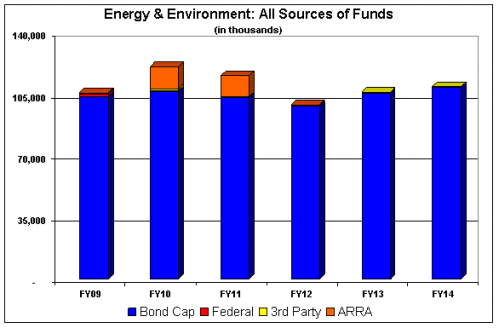Quick Links
- Report
- Introduction
- Accomplishments & Initiatives
- American Recovery and Reinvestment Act of 2009
- Development of the FY10-14 Capital Investment Plan
- Affordability & Fiscal Responsibility
- Aggregate FY10-14 Capital Investment Plan
- Capital Investments by Investment Category
- Appendix A - Debt Affordability Analysis
- Appendix B - Bond Bills
- Appendix C - Project Listing (xls)
- Appendix D - Project Descriptions (pdf)
- Plan by Investment
- Plan by Capital Agency
- Plan by Beneficiary Agency
- Downloads
- Site Map
Energy and Environment
The Executive Office of Energy and Environmental Affairs (EOEEA) stewards an incredible diversity of natural resources and infrastructure for the Commonwealth. Ten percent of the Commonwealth’s land mass is in state parks, forests and other conservation lands – including 450,000 acres of state forest and park systems. In addition to state parks and forests, the Department of Conservation and Recreation (DCR) manages 29 campgrounds, 87 beaches, 340 dams, 524 miles of urban parkways and 2,000 miles of trails. The Department of Fish and Game oversees over 157,000 acres of Wildlife Management Areas and maintains over 275 boat ramps and public access fishing and boating sites.
Managing these resources requires significant investments from both the operating and capital budgets. In particular, capital funds pay for important infrastructure projects, such as flood control measures, dam rehabilitation, improvements to recreational facilities, wildlife habitat protection, environmental hazard remediation, park and trail maintenance, and open space acquisition. Other agencies within EOEEA invest capital resources in projects and programs that contribute to clean water, clean air, clean energy, natural resources, agricultural resources and more.
The Administration’s FY10-14 capital investments in energy and the environment are shown on the following graph and compared to projected FY09 investments.

Highlights of the FY10 energy and environment capital investments include:
-
Complete Georges Island Visitor Center which will have extensive exhibits, shade shelter, concession services, event space and a gift shop to anchor Georges Island as a hub of Boston Harbor Islands State Park and to enhance it as a tourism destination. The installation of solar panels and the energy conservation measures at the visitor center will have projected annual savings of two-thirds of the current operating costs.
The capital investment plan provides for $45 million in FY10 dedicated to open space protection. Some of these land protection investments are in the form of grants to municipalities and are reflected in the Community Investment category described above. In the aggregate these land protection investments are being targeted to three main objectives: (1) the creation of urban parks, (2) the preservation of natural landscapes and habitats; and (3) the preservation of working landscapes.
Maintain robust swimming pool program to complete rehabilitation of five urban pools by FY13.
Commence the $10.3 million Winthrop Shores restoration project which includes beach nourishment for shore protection, parkway reconstruction and reconstruction of storm drainage.
It should be noted that the five-year capital plan contains a number of other energy and environment investments reflected in other spending categories. For example, repairs required for Department of Conservation and Recreation (DCR) roads and bridges, particularly through the Accelerated Bridge Program, are reflected in the Transportation category in recognition of the fact that these and other DCR roads and bridges are transportation assets. In addition, the energy and environment investments shown in the chart above do not reflect energy and environment-related community investments, particularly in the area of land conservation programs for which the Administration significantly increased funding beginning in FY08. There are also amounts budgeted for energy efficiency improvements in state facilities reflected in the State Office Buildings and Facilities category described below that are not reflected in the chart above.
ARRA Funding
To date, the Commonwealth has been awarded $74 million in energy-related ARRA funds.
$55 million of which is from the State Energy Program. This program has three primary components: renewable energy projects, energy efficiency projects and energy efficiency transformation projects. In FY10, the Commonwealth will spend approximately $5 million and $12.5 million of State Energy Program funds for solar and energy efficiency projects at state university and college campuses and at state office buildings, respectively. In FY10, the Commonwealth will award $10 million to promote the expansion of private sector efficiency programs under transformation program.
Under the Energy Efficiency and Conservation Block Grant program, the Commonwealth has been awarded $14 million, of which $7 million will be spent in FY10, to provide funds to communities with populations less than 35,000 to implement projects to reduce fossil fuel use and emissions.
The Commonwealth has also been awarded nearly $5 million in Leaking Underground Storage Tank Trust Fund Program and Diesel Emissions Reductions Program funds. In FY10, nearly $1 million will be spent on underground storage projects and $1.3 million on the diesel emissions reductions program.
In addition to the ARRA funds mentioned above, the Massachusetts Water Pollution Abatement Trust has been awarded $133.1 million of ARRA funding for local wastewater infrastructure projects and $52.2 million for local drinking water projects. In FY10, the Trust expects to expend $85 million and $33 million of these amounts on wastewater and drinking water projects, respectively. These funds have not been reflected in this capital plan, since they are awarded directly to the Trust and do not flow through the Commonwealth.
Other energy-related ARRA competitive grant programs for which the Commonwealth will apply include the competitive portion of the Energy Efficiency and Conservation Block Grant which will select state and local government program proposals that could transform the speed and scale with which energy efficiency technology is installed in homes, businesses, and other buildings.
[1] University of Massachusetts, Donahue Institute, Massachusetts State Data Center, 2008 Q3 data, p. 20.
 top of page
top of page